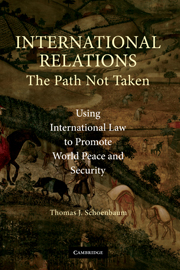Book contents
- Frontmatter
- Contents
- Preface and Overview
- 1 Introduction: Two Very Different Wars in Iraq
- 2 The Twenty-First Century – The End of History or a New Beginning?
- 3 International Power Politics
- 4 A New Global Order Based on International Law and Multilateralism
- 5 Peace and Security: Reinventing the United Nations
- 6 International Political Economy
- 7 International Environmental Protection
- 8 International Human Rights
- 9 International Crimes
- 10 Conclusions
- Index
- References
5 - Peace and Security: Reinventing the United Nations
Published online by Cambridge University Press: 23 July 2009
- Frontmatter
- Contents
- Preface and Overview
- 1 Introduction: Two Very Different Wars in Iraq
- 2 The Twenty-First Century – The End of History or a New Beginning?
- 3 International Power Politics
- 4 A New Global Order Based on International Law and Multilateralism
- 5 Peace and Security: Reinventing the United Nations
- 6 International Political Economy
- 7 International Environmental Protection
- 8 International Human Rights
- 9 International Crimes
- 10 Conclusions
- Index
- References
Summary
“We are led by events and common sense to one conclusion: The survival of liberty in our land increasingly depends on the success of liberty in other lands. So it is the policy of the United States to seek and support the growth of democratic movements and institutions in every nation and culture, with the ultimate goal of ending tyranny in our world.”
President George W. Bush, Second Inaugural Address, January 22, 2005“The stark reality is that the United States does not have the right structural capacity to stabilize and rebuild nations. … The United States needs an effective United Nations.”
Samuel R. Berger and Brent Scowcroft, National Security Advisors to Presidents William Clinton and George H. W. Bush, respectively, July 27, 2005THE OPPORTUNITY FOR A NEW BEGINNING
The present generation of world leaders has an opportunity that comes exceedingly seldom in historical terms: They are being called upon to restructure the global architecture that is responsible for world peace and security. To grasp the importance of this opportunity, consider this: The last time this opportunity was possible was in 1945 (the end of World War II); before that it was in 1918 (the end of the First World War) and before that it was in 1815 (after the wars against Napoleon).
The task presented is to thoroughly reform and update all aspects of the United Nations.
- Type
- Chapter
- Information
- International RelationsThe Path Not Taken, pp. 96 - 147Publisher: Cambridge University PressPrint publication year: 2006

